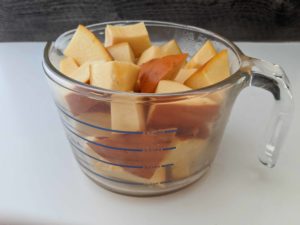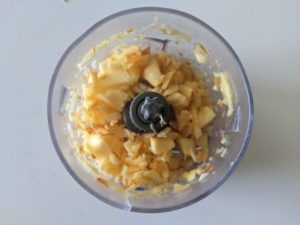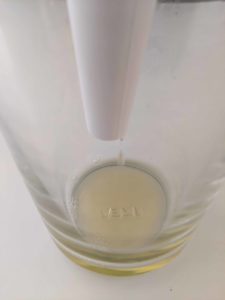Extract DNA from a Pumpkin
Extract DNA from a pumpkin using household materials.
Materials
- 1 Medium Pumpkin
- 1/2 Cup Isopropyl alcohol, 70% or 91%. This should be cooled in a freezer for about an hour.
- 1 Tablespoon Salt (regular table salt)
- 1/4 Cup Clear dish washing soap
- Beakers, test tubes or cylinder or small glass cups will work
- 1 Liquid measuring cup
- 1 Tablespoon measuring spoon
- 3-4 Coffee filters
- 1 Blender. We used a NutriBullet
- 1 Funnel
Instructions
- Cut off a section of the pumpkin and clean off the “insides.” Cut the pumpkin into small chunks that will fit into the blender.

- Add 1/2 cup of water.
- You want to blend it just enough to cut the pumpkin into small pieces but not liquefy it. We did about 5 pulses on our blender. When we over-processed the pumpkin, it may have obliterated the DNA, which may have been why our first batch didn't work.

- If your blender is too full, carefully transfer the pumpkin to a bowl and add one tablespoon of salt.
- Add 1/4 cup of the clear dishwashing liquid. Stir carefully with a spoon, but mix thoroughly.
- Place the coffee filter securely into the funnel, and place the funnel securely over a glass beaker or cylinder or a drinking glass

- Fill the funnel 2/3 of the way with the pumpkin mixture. Allow the pumpkin water to drain for 20 minutes or so. We made a makeshift funnel with another coffee filter and a small beaker, to help facilitate this step in the process.
- When enough pumpkin water has drained, gather the 1/4 of isopropyl alcohol. Tilt the glass slightly and slowly put the alcohol into the glass down the tilted side of the glass. The goal is to form a layer of the alcohol on top of the pumpkin water. Gently place the glass flat on the work surface and wait.
Notes
- Put the alcohol in the freezer for at least 2 hours. Alcohol does not freeze, so you cannot get the alcohol too cold.
- We opted for clear dishwashing liquid without any strong scents. Below is a photo of the label from the dish soap we used
- It takes a while for the liquid from the pureed pumpkin mixture to drain through the coffee filter. We set up two glasses with funnels and filters and a makeshift funnel (pictured below).
- We used our Ninja instead of a full-sized blender.